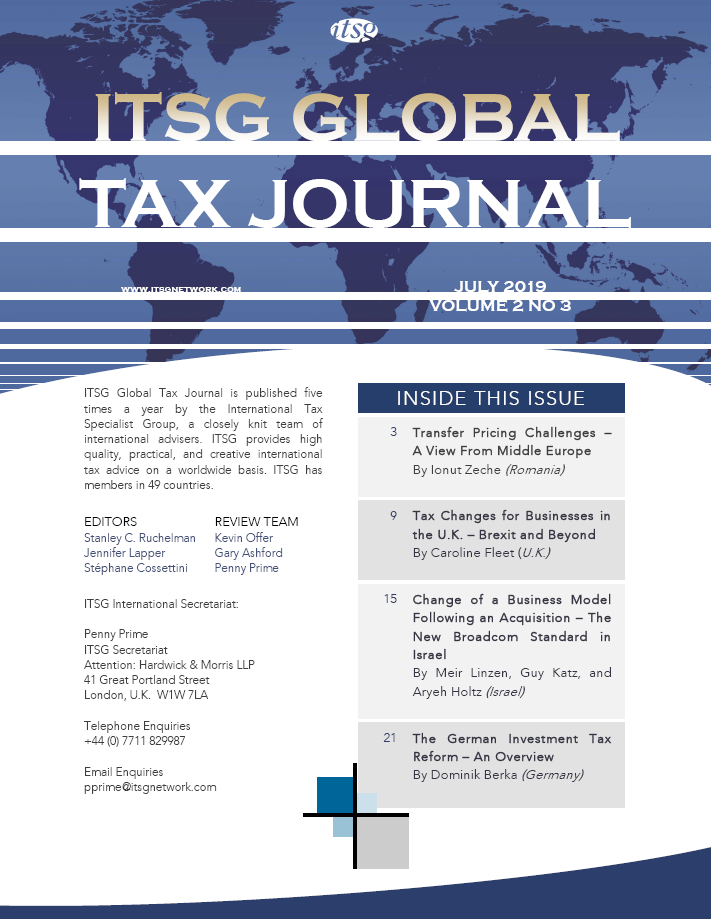General background
Israel has been known as a “Start-Up Nation”, home to companies and entrepreneurs responsible for numerous inventions in all the technological fields, including some of great significance. Among them are:
- the Waze navigation system,
- MobilEye’s safety systems for autonomous cars,
- Frutarom's biotechnology,
- M-Systems’ USB drive,
- Checkpoint’s firewall software,
- Mellanox's technology for communication equipment,
- online gaming technologies used by companies such as Playtika and Plarium, and
- technical pharma companies such as Teva and Lumines.
These comprise the tip of the iceberg.
For many years, the Israeli government understood the importance of the high-tech industry as an engine of the Israeli economy. It provided various incentives to technology companies, including significant tax benefits and grants. Recently, the Israeli Law for Encouragement of Investment of Capital was amended and new preferred tax regimes were presented in order to provide the local high-tech industry with additional incentives and to encourage M.N.E.s to invest in Israel. Several special regimes were introduced for high-tech companies that as a group have an annual worldwide income higher than NIS 10 billion, or roughly U.S. $2.8 billion based on exchange rates as of July 2019. Other regimes relate to companies providing research and development (R&D) services to non-Israeli enterprises.
In contrast to the above, tax experts in Israel have been witnessing a disturbing tendency in the Israeli Tax Authority (I.T.A.) to subject Israeli companies to an overly aggressive tax examination whenever an M&A transaction occurs. The main issue pursued in these examinations involves an assertion that all functions, assets, and risks of the acquired business have been transferred to the acquiring M.N.E. at the time of the transaction or shortly thereafter. In the I.T.A.’s view, this creates a very significant capital gains tax event for the acquired Israeli company, usually equal to the amount involved in the acquisition plus secondary adjustment which is treated as a dividend.
Business restructuring and transfer of functions assets and risks
Local legislation and O.E.C.D. publications
In 2002, Section 85A "Transfer Pricing in an International Transaction" was added to the Israeli Income Tax Ordinance (New-Version) – 1961 (the Ordinance). The section provides as follows.
In an international transaction, in which there are special relationships between the parties to the transaction…, the transaction shall be reported according to market terms and charged tax accordingly.
In November 2006, the I.T.A. published Income Tax Regulations (Determining Market Terms), 2006 (the Regulations), implementing Section 85A. The Regulations applied to all international transactions taking place from the date of publication. Nonetheless, a transfer pricing study conducted prior to the implementation date would continue to be admissible for a two-year period, provided it was conducted according to O.E.C.D. guidelines.
In 1996, the O.E.C.D. published the report "Transfer Pricing and Multinational Enterprises". This publication was supplemented several times until 22 July 2010, when the "O.E.C.D. Transfer Pricing Guidelines for Multinational Enterprises and Tax Administrations" (the Guidelines) was published. In 2014, the O.E.C.D. and G-20 published the "Guidance on Transfer Pricing Aspects of Intangibles" as part of the B.E.P.S. Project. This amended Chapter VI of the Guidelines regarding Special Consideration for Intangibles. The chapter was completely deleted and replaced with a new one. On 10 July 2017, the O.E.C.D. released “Transfer Pricing Guidelines for Multinational Enterprises and Tax Administrations 2017”. This guidance incorporates substantial revisions made in 2016 to reflect the clarifications and revisions agreed in the 2015 B.E.P.S. Reports on Actions 8-10 “Aligning Transfer pricing Outcomes with Value Creation” and Action 13 “Transfer Pricing Documentation and Country-by-Country Reporting”. It also includes the revised guidance on safe harbours approved in 2013, which recognises that properly designed safe harbours can help to relieve some compliance burdens and provide taxpayers with greater certainty. On 21 June 2018, the O.E.C.D. released “Guidance for Tax Administrations on the Application of the Approach to Hard-to-Value Intangibles”, under B.E.P.S. Action 8 and “Revised Guidance on the Application of the Transactional Profit Split Method”, under B.E.P.S. Action 10.
Following the publication of the Guidelines and the B.E.P.S. Project, the I.T.A. began issuing tax assessments, asserting that functions, assets, and risks were transferred in connection with M&A transactions. The premise on which the assessments were based was that intangibles were acquired by the M.N.E. group effecting the acquisition at prices that were less than arm’s length. These assessments also relied on Section 86 of the Ordinance, which relates to sham and artificial transactions. The I.T.A. has the authority to re-characterize transactions believed to be artificial and entered for the purpose of reducing or avoiding tax payments.
The Gteko court case
The Gteko case1 is the leading court ruling in Israel on business restructuring. It was decided in November 2017). Gteko Ltd. (Gteko) shares were purchased by Microsoft in November 2006 for a consideration of $90 million. Shortly thereafter, all of Gteko's workforce were transferred to Microsoft. In July 2007, Gteko and Microsoft signed an agreement under which Microsoft acquired all Gteko I.P. for a consideration of $26.6 million (the I.P. Value). The I.P. Value was determined based on the purchase price allocation (P.P.A.) of the Gteko shares for accounting purposes. The allocation was prepared by Duff & Phelps. The I.T.A.'s assessment to Gteko was based on the excess of $90 million (i.e., the P.P.A.) and the I.P. Value determined by Duff & Phelps. The I.T.A. claimed that, de facto, Gteko transferred all of its functions, assets, and risks to Microsoft and not only the I.P. as reported. The court ruled in favour of the I.T.A. on this point.
The I.T.A.’s circular
Following the Gteko case, the I.T.A. published a circular2 in November 2018. In the circular, the I.T.A. instructed its local officers to identify post-acquisition business restructurings. Local officers were provided with a standard form questionnaire to be answered by the acquired companies.
According to the I.T.A., its position is based on amended Chapter VI and on Chapter IX of the O.E.C.D. Guidelines that were published in 2017 and on the Gteko case. Based on our understanding, the I.T.A.’s position appears to be an extremely aggressive application of the Guidelines towards companies that were acquired and restructured. The I.T.A. argues that the transfer of I.P. basically means that the M.N.E. is emptying out the Israeli target and leaving it somewhere between a low-risk distributer and an empty shell. In this way, the M.N.E. removes value from the Israeli target without adequate payment. In addition, the I.T.A. often argues for secondary adjustments contending that, once the transaction is restructured to be a sale at arm’s length, the amount deemed to have been received was either distributed by the Israeli company to the M.N.E. as a dividend or advanced as a loan to the M.N.E. As a final adjustment, a penalty for improper reporting has been frequently asserted.
The Broadcom court case
In February 2019, an interim court ruling was published on the Broadcom case3, regarding the burden of proof in business restructuring cases. The ruling sheds light both on new arguments raised by the I.T.A. and the view of the court on the validity of those arguments.
Broadcom Broadband Excess Ltd. is an Israeli resident company (the Israeli Company), that was held by Broadlight Inc. (the Parent Company). In March of 2012, Broadcom Corporation (Broadcom) purchased all of the Parent Company's shares for a consideration of $200 million. Less than three months later, the Israeli Company entered into three agreements with companies of the Broadcom group:
- The sale of all the Israeli Company's I.P. for a consideration of $59.5 million
- An agreement to provide R&D services for a cost + 8% margin
- An agreement to provide marketing and technical support services for a cost + 10% margin
The I.T.A. claimed that the actual agreement was of a much larger scale and included a sale of most of the functions, assets, and risks of the Israeli Company.
According to the I.T.A.'s position, the transaction between the Israeli Company and a Broadcom Cayman Company in the framework of the R&D Agreement was substantially more extensive than presented. The I.T.A. argued that the entire transaction included not only the Israeli Company's I.P., but all the tangible and intangible functions, assets, and risks. An interesting point is that the I.T.A. did not dispute the value of the I.P. sold or the cost-plus mark-up in the R&D and marketing contracts.
Following a tax assessment, an appeal for court review was filed. In the petition, Broadcom requested a shift in the burden of proof from the appellant – the taxpayer instituting the appeal to the appellee – the I.T.A. The dispute in the appeal is whether the sale of the I.P. by Broadcom should be considered as a business restructure in which the functions, assets, and risks were sold or be respected as a sale of I.P. At this stage, the discussion in the case has focused on the burden of proof in characterizing the sale of I.P. as a business restructure. No decision has been reached as to the scope of the transaction and whether it included functions, assets, and risks.
Section 86 – Sham and artificial transaction
The court decision began by acknowledging that the usual rule in tax appeals is that the burden of proof rests on the appellant, as it is the one raising the claim. This stems from the fact that the appellant has a preferred position. It has easy access to all the information regarding the conduct of the business and, therefore, is in the position to prove the relevant facts that refute the assessment.
However, the usual rule is reversed when the tax assessor relies on Section 86 of the Ordinance to argue that a transaction is a sham or artificial transaction. When the tax assessor claims artificiality under Section 86 of the Ordinance, it asserts the creation of a new transaction for tax purposes, rather than the transaction made by the taxpayer. In this case, the appellant’s relative advantage of knowing the relevant facts no longer exists. The normative basis for imposing the burden of proof shifts to the I.T.A. The tax assessor has asserted a “new” transaction. Consequently, it is the assessor’s responsibility to explain the validity of that assertion. Since the tax assessor is the one who knows the basis for claiming that the transaction is artificial, it is appropriate for the tax assessor to be the first to bring the court evidence for the basis of the claim. Only then should the taxpayer be required to present evidence to refute the assertion.
The taxpayer’s argument regarding a shift in the burden of proof was unsuccessful. According to the court, the I.T.A. claimed that it did not make use of the special authority granted under Section 86 of the Ordinance to argue that the transaction was artificial but merely classified it differently according to its true economic nature. In order to explain the difference between the artificial transaction argument and the different classification argument, the court cited the holding in another case4:
When the tax assessor uses his authority to 'reclassify the transaction' [i.e., different classification], he does not adopt the factual representation presented by the taxpayer, because in his opinion this representation does not accurately reflect the factual reality. And it is correct – he does not adopt the representation and therefore finds it necessary to make a different representation under it. He does not 'change' the facts. This activity of the tax assessor is 'in the world of action'...or for the least part, in the world of general law, rather than in the 'tax world', and in this respect he does not even need the special 'disregard' provision set out in Section 86 of the Ordinance.
On the other hand, when the tax assessor uses his authority under Section 86 of the Ordinance, and since this is a residual authority...he does so only after he reaches the conclusion that in the 'world of actions', or in the world of general law, the real transaction is as presented by the taxpayer and that it cannot be classified differently. Only then does the tax assessor turn to the special tools given to him by the Income Tax Ordinance, including Section 86 of the Ordinance, which allows him to ‘ignore’ the transaction (including the construction of another transaction under it, since both the ‘destructive’ authority and the ‘constructive’ (restructuring) as determined in CA 3415/97 Pashmag vs. Yoav Rubinstein & Co., Misim 17/4, (2003)), and 'creates' a new transaction 'in the tax world' and for tax purposes only.
Section 85A – Transfer pricing
The Israeli Company also made the claim that Section 85A of the Ordinance (mentioned above) applies in this instance. This section states that in case the company files the required documentation, as required by the section, "the assessor shall have the duty of evidence if he has made determinations different from the agreements between the parties". The argument is that as the I.T.A.'s assessment was determined under Section 85A of the Ordinance, and given that Broadcom met all the requirements of Section 85A, the I.T.A. should have the burden of proof. The court's view was that the I.T.A. does not dispute the transfer pricing study provided but, rather, does not accept the scope of the transaction as presented. For this reason, the transfer pricing study is irrelevant for determining the value of the transaction, and therefore, the section does not apply. This is also in line with the court ruling in Gteko.
Transfer of assets v. transfer of functions & risks
One last interesting point is the argument that the transfer of functions, assets, and risks is not considered as a taxable event under any Israeli law, and at most, the transfer of assets can be taxed but not the transfer of functions and risks. This claim was rejected by the court, which stated that it has not found why general law does not allow the sale of an "activity", including the ability to perform certain functions and to carry certain associated risks.
Court decisions in context
Although Broadcom's appeal to shift the burden of proof to the I.T.A. was rejected by the court, the more important point is that the court has adopted an aggressive approach regarding M.N.E. business restructurings, which validates the tax officers’ approach to these matters. More than the specific ruling, the court’s harsh view of Broadcom is evidenced by fully accepting the I.T.A.'s claims, even if reaching that result requires convoluted legal acrobatics. This interim ruling can give us a glance of what companies are expected to face should they look to the courts restraining the I.T.A.’s business restructuring assessments. Indeed, on 25 March 2019, the court ruled on three appeals by Gottex Israel group5 regarding seven requests to shift the burden of proof to the I.T.A. Not surprisingly, six out of the seven requests were denied.
Another interesting point in the Broadcom case, is that I.T.A. argued for a tax gross-up on the purchase price, adding approximately 25% to the assessments value. The I.T.A. claimed that the value of the shares of the Parent Company, in the amount of $200 million, should serve as a basis for determining the market value of the assets that were released by the Israeli Company. However, the value of the shares cannot be equal to the value of the Israeli Company's property, as it does not take into account the corporate tax component that would be imposed on the Israeli Company had it sold its assets to a third party. As such, the I.T.A. made an adjustment for the Israeli Company's corporate tax component, at a rate of 25%, and grossed up the corporate tax at the value of the sale of the Parent Company's shares. It is not completely clear how this calculation was executed, but it should be explained when the final court ruling is published.
Final comments and conclusions
Broadcom is not the only case to address the I.T.A.’s policy of attacking business restructuring. We have encountered similar arguments in many acquisitions and in cases with various types of post-acquisition relationships between the M.N.E.’s and the Israeli companies, including the following:
- The Israeli company sells the I.P. to the M.N.E.
- The M.N.E. and the Israeli company initiate a joint venture for the development of a new technology to which each of the companies provided its I.P. The sale of I.P. argument has been contemplated, even where the Israeli company was entitled to arm’s length compensation for the use of its I.P.
- The Israeli company grants the M.N.E. a license to its technology, under which the M.N.E. is entitled to utilize the I.P. and include it in its own technology or products, in consideration for arm’s length royalty payments.
- The M.N.E. provides the Israeli company with sales and marketing services, where the I.P. remains owned by the Israeli company, which receives most the revenues from the product.
As the I.T.A.’s arguments on this matter are relatively new and innovative, most of the audits in which these arguments have been raised are still proceeding in first stage audits or administrative appeals to an I.T.A. team or are being argued within an appeal before a district court. The Israeli Supreme Court has not yet ruled on a case involving these issues.
Notably, the I.T.A.’s position was also upheld within an international arbitration process under which the U.S. technology company HP and the Israeli company Mercury argued that a NIS 1.6 billion transfer assessment based on functions, assets, and risks had no merits. In this case, the I.T.A. made significant progress in international arbitration.
As noted above, we believe that the I.T.A.’s position on this matter is not aligned with the Guidelines and, in many cases, does not have any merit. Accordingly, M.N.E. are advised to challenge the I.T.A.’s argument both within the audit procedures and by filing an appeal in court. In addition, it is recommended for the M.N.E. to initiate competent authority proceedings under an applicable double tax treaty. We are aware of several cases that are currently under discussion within such procedures.
Notwithstanding the above, it should be noted that a tax-efficient structuring of the M&A transaction and the Israeli company’s activity following the acquisition may mitigate the exposure to a post-transaction audit regarding a transfer of functions, assets, and risks. Moreover, we believe that in certain cases, it may be possible to obtain a pre-ruling from the I.T.A. or an advance pricing agreement that should prevent later challenges from the I.T.A. in the course of a tax examination following the acquisition.
1 49444-01-13 Gteko Ltd. v. Kfar Saba Tax Assessor (6.6.2017)
2 I.T.A. Circular 15/2018 – Business Restructure in Multinational Enterprises (1.11.18)
3 17419-02-18 Broadcom Broadband Excess Ltd. v. Dan Area Assessment Officer (20.2.2019)
4 TA (Center) 34660-02-15 Tsemel Jacobson Ltd. v. Assessing Officer Petah Tikva (27.8.2015)
5 65630-01-18 Gottex Swimwear Brands Ltd. v. Tax Assessor for Large Enterprises (25.3.2019); 65519-01-18 Gottex Retail Brands Ltd. v. Tax Assessor for Large Enterprises (25.3.2019); and 61394-10-15 Gottex Swimwear Brands Ltd. v. Tax Assessor for Large Enterprises (25.3.2019).

 Login
Login





















































